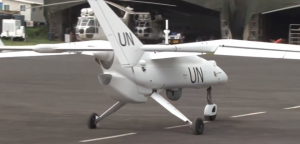UN Launches Its Own Spy Drone Program
UNITED NATIONS, 9 Dec 2013
Allen McDuffee, Wired – TRANSCEND Media Service
The United Nations has turned to spy drones for the first time in its history in an effort to increase pressure in militias in the Democratic Republic of the Congo, marking both a major technological advancement in the organization’s peacekeeping arsenal as well as a shift in how it views the use of unmanned aerial vehicles.
“Such high-technology systems allow a better knowledge of what is happening on the ground, which allows a force to better do its job,” Hervé Ladsous, Under Secretary General for Peacekeeping Operations, told journalists upon his arrival in Goma this week.
The first two drones were launched on Tuesday from the eastern city of Goma and officials expect another drone to be deployed by the end of the month with more to be delivered in the spring.
“With this kind of equipment, we should be able to combine information gathered in flight with information gathered on the ground by people,” said Santos Cruz, Force Commander General Santos of MONUSCO, the UN’s stabilization mission in Congo.
For now, the deployment, which was authorized by the Security Council earlier this year, is limited to Congolese air space and the drones are strictly for surveillance purposes so that the UN can better track population fluxes, the movement of armed groups and areas of the country that are typically difficult to monitor.
“They sorely need dedicated ISR [Intelligence, Surveillance and Reconnaissance] capabilities,” said Micah Zenko, a senior fellow at the Council on Foreign Relations. “The hold up isn’t opposition to drones, per se, but more typical funding issues.”
However, the UN has routinely criticized the U.S. and British governments for their drone activities, albeit mostly for strikes.
“The most prolific user of targeted killings today is the United States, which primarily uses drones for attacks,” wrote Philip Alston, special investigator to the UN Human Rights Council, in 2009. “Some 40 states already possess drone technology, and some already have, or are seeking, the capacity to fire missiles from them.”
Perhaps self-aware of its own forthcoming drone turn, the organization struck a softer tone in two major reports on drones it published in October, where it called for greater transparency from the United States by releasing data.
“The single greatest obstacle to an evaluation of the civilian impact of drone strikes is lack of transparency, which makes it extremely difficult to assess claims of precision targeting objectively,” wrote UN special rapporteur Ben Emmerson in one of the two reports.
It may be easy for the UN to be transparent about the Congo, but as drone operations expand — as they always seem to do — to other situations and other agencies, how much will we know?
“It is another validator of the new ‘normal’ of this technology and its use,” said Peter Singer, director of the Center for 21st Century Security and Intelligence at the Brookings Institution. ”Some 87 countries are using military robotics of some sort, so why should we be stunned that the organization they are members of and supply its forces would use them too?”
“Drones are a technology that are here to stay,” said Singer. “There are so many ‘debates’ now where the people call themselves ‘pro’ or ‘anti’ drone, which is like being pro or anti computers, quaint but irrelevant. Its all about how you use the technology, not the widget itself.”
httpv://www.youtube.com/watch?v=Z6uag2TSdoU#t=12
DISCLAIMER: The statements, views and opinions expressed in pieces republished here are solely those of the authors and do not necessarily represent those of TMS. In accordance with title 17 U.S.C. section 107, this material is distributed without profit to those who have expressed a prior interest in receiving the included information for research and educational purposes. TMS has no affiliation whatsoever with the originator of this article nor is TMS endorsed or sponsored by the originator. “GO TO ORIGINAL” links are provided as a convenience to our readers and allow for verification of authenticity. However, as originating pages are often updated by their originating host sites, the versions posted may not match the versions our readers view when clicking the “GO TO ORIGINAL” links. This site contains copyrighted material the use of which has not always been specifically authorized by the copyright owner. We are making such material available in our efforts to advance understanding of environmental, political, human rights, economic, democracy, scientific, and social justice issues, etc. We believe this constitutes a ‘fair use’ of any such copyrighted material as provided for in section 107 of the US Copyright Law. In accordance with Title 17 U.S.C. Section 107, the material on this site is distributed without profit to those who have expressed a prior interest in receiving the included information for research and educational purposes. For more information go to: http://www.law.cornell.edu/uscode/17/107.shtml. If you wish to use copyrighted material from this site for purposes of your own that go beyond ‘fair use’, you must obtain permission from the copyright owner.
